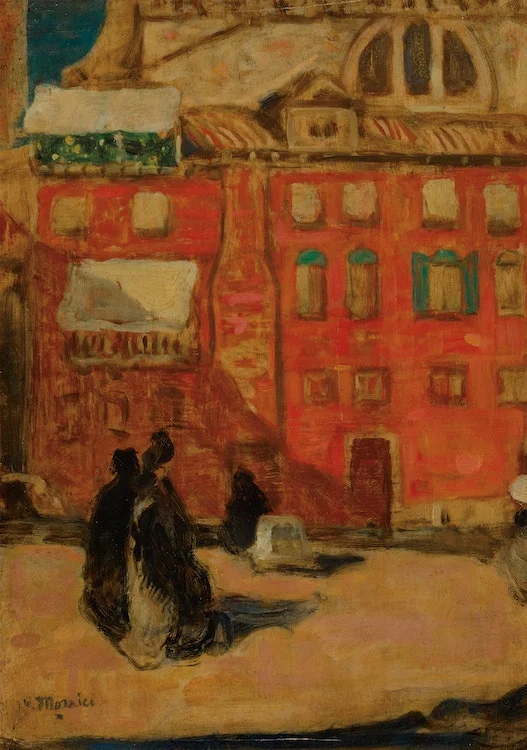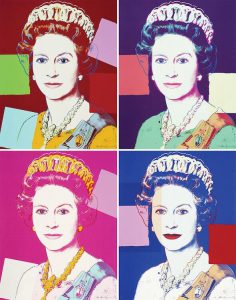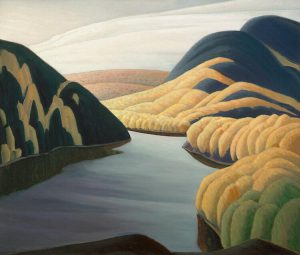Rob Cowley Chats with Mona Mahmoud at CTV Morning Live Vancouver about the Upcoming Spring Auction Season at Cowley Abbott. They discuss the ten commandments of valuing artwork, along with artworks by Emily Carr, Lawren Harris, Tom Thomson and Andy Warhol, each being offered in the Cowley Abbott Spring Live Auction on June 8th, 2023.
William Kurelek was a skilled storyteller, whose work provides his insight related to a wide variety of personal subjects which often focused upon his life, heritage, and religion. Kurelek’s most celebrated compositions continue to be those which reflect his upbringing and memories of life on the farm. The painter’s work explored both the tender and the gruelling aspects of daily life on the Prairies, the scenes populating the 1964 Isaacs Gallery exhibition An Immigrant Farms in Canada, the first of several such shows which Kurelek would present.
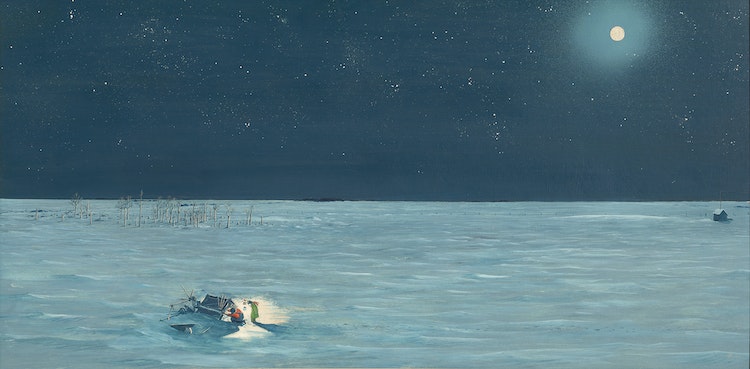
This painting, A Bolt Like That, painted in 1965, was not featured in these exhibitions, however it does appear in William Pettigrew’s 1967 National Film Board documentary, Kurelek. The captivating beauty of Kurelek’s expansive prairie landscape led the owner to purchase the painting from Toronto’s Isaacs Gallery soon after it was painted, A Bolt Like That remaining in their collection for close to sixty years, soon to make its auction debut with Cowley Abbott during the June 8th Live Auction of Important Canadian & International Artwork.
Rob Cowley & Lydia Abbott visit CTV Morning Live Winnipeg’s Rachel Lagacé to discuss the Art Market and the Cowley Abbott Spring Live Auction of Important Canadian Art on June 8th, 2023. Artworks by Lawren Harris, Tom Thomson, David Bowie and Andy Warhol are discussed during the segment.
The outbreak of war in 1914 proved devastating to Toronto’s graphic art industry where most of the future members of the future Group of Seven earned their livings. In the fall of 1916 Arthur Lismer left for Halifax to teach at the Victoria School of Art. The Halifax period proved to be productive, but he longed to return to Toronto and in fall 1919 he was appointed vice-principal of the Ontario College of Art. Teaching and administration proved to be demanding, leaving little time to paint. All of his works included in the first exhibition of the Group of Seven from 7 to 27 May 1920 had been previously exhibited.
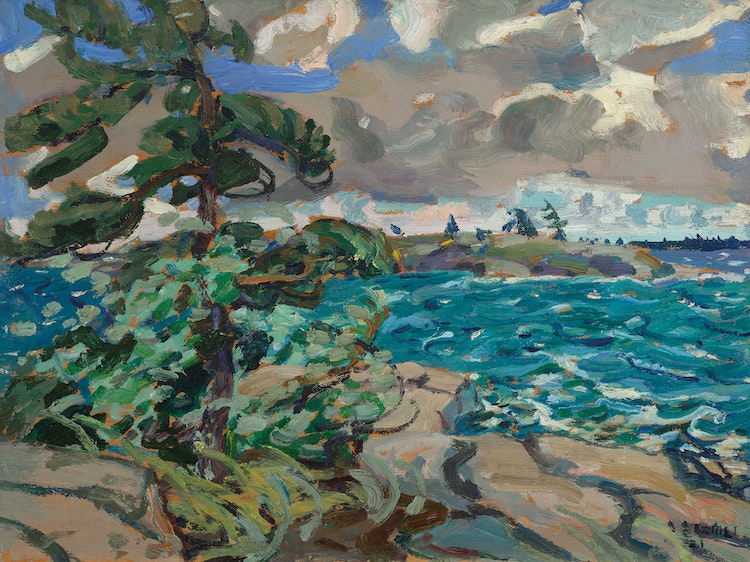
However, even before the Group show had closed, Lismer, Lawren Harris and A.Y. Jackson left Toronto to paint around Mongoose Lake in Algoma with Dr. MacCallum. MacCallum then invited Lismer and Fred Varley to spend time at his cottage on Go Home Bay in Georgian Bay. Lismer had previously painted there in the fall of 1913 and spring 1915. On the latter occasion he painted the sketch for “A Westerly Gale, Georgian Bay” (sketch and canvas in the National Gallery of Canada, acc. nos. 4743 and 1368), a storm blown pine on a high foreground against open water and rocky islands, the precursor of “A September Gale”. Varley exhibited Georgian Bay canvases in the spring of 1917 resultant from a visit the previous year, and Maria Tippett has argued that his famous canvas, “Stormy Weather, Georgian Bay” (sketch and canvas in National Gallery of Canada, acc. nos. 4582 and 1814), resulted from this 1916 trip to the Bay. However, it is more likely that Lismer and Varley painted at Go Home Bay in the summer of 1920 and painted their respective canvases, “September Gale” and “Stormy Weather, Georgian Bay”, during the winter of 1920-1921. Both canvases are tributes to Tom Thomson’s “West Wind” (Art Gallery of Ontario, acc. no. 784) and were included in the Group of Seven exhibition in May 1921.
“A September Gale” was possibly the most ambitious painting Lismer had painted to date and was preceded by two oil sketches and one small canvas. Barry Lord has given the most complete discussion of the development of the final painting though the existence of the oil sketch being offered here was not known when he wrote in 1967.
Lord identified the oil sketch, dated 1920, now in the Vancouver Art Gallery, as the first study of the theme. The wind blown pine is rudimentarily sketched in and the wind blown clouds and sky dominate the composition. In the small canvas in the National Gallery, also dated 1920, the somewhat spindly tree takes centre stage, breaking the picture plane at the top, rising from behind the rocks rather than in the midst of them, reeds and a root are detailed lower right, and, as Lord writes, “Space is found for the two subsidiary tree forms to the left, although they remain quite flabby and inconclusive.”
In the oil sketch being presented here, the tree is rooted in the rocks, surrounded by broadly sketched foliage, compressed between the upper and lower edges of the panel and the rocks lower left, energizing the landscape. The foreground root has been eliminated, the light is more luminous and the channel between the islands enlarged. The lessons learned in this superb sketch will be incorporated in the final canvas of 1921 in which the tree retains the simplified design and the compression of the sketch. The space is opened at the left further enlarging the “flabby” subsidiary trees, and the islands at the right become more distant. In enlarging the sketch forms have become more sculptural, as seen in the clouds and waves, in the rocks lower left and in the reeds that now bend in the wind.
Arthur Lismer has written most evocatively of this painting. “[A]mong the outer islands and shoals stretching far out into the main channel … the rocky islands are more broken and rugged, and the trees take on forms and shapes that result from the constant buffeting of storm and ice. The little pines have taken tenacious hold in clefts and crannies of the broken rock wherever they could send down a clinging root into the rare pockets of soil….’September Gale’… is essentially a picture of movement; everything in it is alive with related action or rhythm … it is like a nature symphony with clashing chords and deep undertones of menace – orchestration with many instruments striving to achieve a powerful expression.”
We extend our thanks to Charles Hill, Canadian art historian, former Curator of Canadian Art at the National Gallery of Canada and author of “The Group of Seven‒Art for a Nation”, for his assistance in researching this artwork and for contributing the preceding essay.
Paul Peel spent much of the summer of 1887 in the French fishing port of Étaples-sur-mer, Pas-de-Calais, site of a colony of international artists. It was in Étaples that he found local girl, Marie, who became a favoured model for a series of figure paintings completed in 1888.
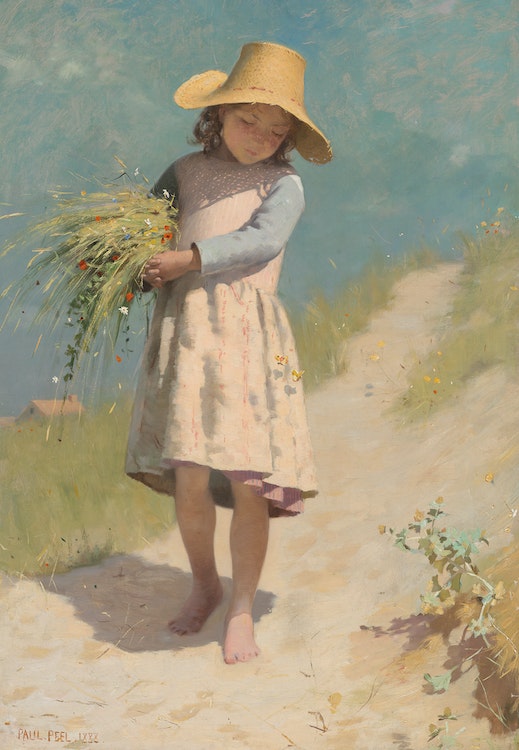
In this canvas, originally titled “The Young Gleaner”, the young girl is depicted outdoors under brilliant sunlight descending an Étaples sand dune, armed with freshly gleaned flowers and captured at the fleeting moment she spies two butterflies. This painting is a slightly larger replica of the canvas (Art Gallery of Ontario) shipped from Paul Peel’s Paris studio to Canada for exhibition: first at the 19th Annual Royal Canadian Academy of Art Exhibition in Ottawa in March 1889 and in April at the Art Association of Montreal Spring Salon. As was a common 19th century practice, Peel frequently replicated his paintings, sometimes in differing scales, for various reasons: additional sales; the artist’s own study/demonstration purposes; or as gifts to family or friends. This version of “The Young Gleaner” was retained by the artist’s Copenhangen-based Danish in-laws, the Verdiers, from whence it descended through the family until its sale in Canada. A third version of the subject is thought to be in private hands.
A primary painterly interest in “The Young Gleaner” is an optically realistic rendering of bright sunlight, an interest shared by most contemporary artists of the day. Peel’s preoccupation with sunlight is underscored by a companion piece, “The Young Botanist”, which depicts little Marie seated examining flowers on the same sand dune under a similarly bleaching sunlight (at least two versions of this composition are known, one in Museum London). A life-sized pastel drawing of “The Young Botanist” was exhibited at the Paris Salon of 1888, under the title “Au soleil” (Frank Gray, of Toronto, would purchase both the pastel (Sunshine) and oil from the artist at Oliver, Coate & Co, Paul Peel Sale in 1890).
Like fellow graduates of the Pennsylvania Academy of Arts and students of Thomas Eakins (Peel graduated in 1880), Paul subscribed to a tonal method of rendering natural light outdoors. This alternative aesthetic of light to French impressionism, practised by most North American artists‒recently coined the Glare aesthetic (William Gerdts, American Impressionism, 1980)‒depends on tonal, rather than colour, contrasts. Here the effort to render bright natural light conditions leads to a bleached palette and flattened forms with reinforced formal outlines (vs impressionist dissolution of form). This method owes a debt to Edouard Manet (whose 1884 Paris retrospective exhibition Peel must have seen).
Peel launched his professional career in France with such studio productions as “The Spinner” (1882, Museé des beaux-art de Montreal), and continued throughout his short career to seek his official credentials by means of idealized domestic genre paintings after the prevailing academic manner. It was at the recommendation of his first French teacher, Jean-Paul Gerome, that the fledging artist began sketching outdoors, first in Pont-Aven, Brittany, where he joined an established seasonal colony of largely American artists. Direct painting outdoors resulted in a number of high-keyed paintings capturing the bright, glaring properties of sunlight on local forms, exemplified by a series of Pont-Aven village views and the small figure study “Bubble Boy” (1884, Art Gallery of Ontario). In 1883, during a visit to his hometown of London, Ontario, Peel applied his new methodology to depict Covent Garden Market (Museum London), under a blazing sun using large, bright planes next to small areas of deep darks to solidify architectural forms.
Like his American friends, Peel’s concern with optical realism (photographs served as memory aids) was tempered by an ongoing academic concern for formal integrity and for appealing pictorial narratives. The bright illumination of little Marie equally evokes a happy mood and carefreeness of a fleeting moment of childhood, one echoing the artist’s personal life in 1887 as a new husband and father of a one-year old son (born the previous October in Étaples). The charm of children would remain a primary selling point of the artist’s production.
We extend our thanks to Victoria Baker, Canadian art historian and author of “Paul Peel: A Retrospective, 1860-1892” for contributing the preceding essay.
Marc-Aurèle de Foy Suzor-Coté had a long practice of studying the female model, a rare subject matter for painters of the period. In 1921 the artist presented Magdalena for sale at $2,000, an unprecedented amount. The artwork was well received by Montreal critics at the time. The curled up position of the woman challenged the stereotypical excellence of the feminine form, a masterful depiction of the nude by a celebrated Quebec artist.
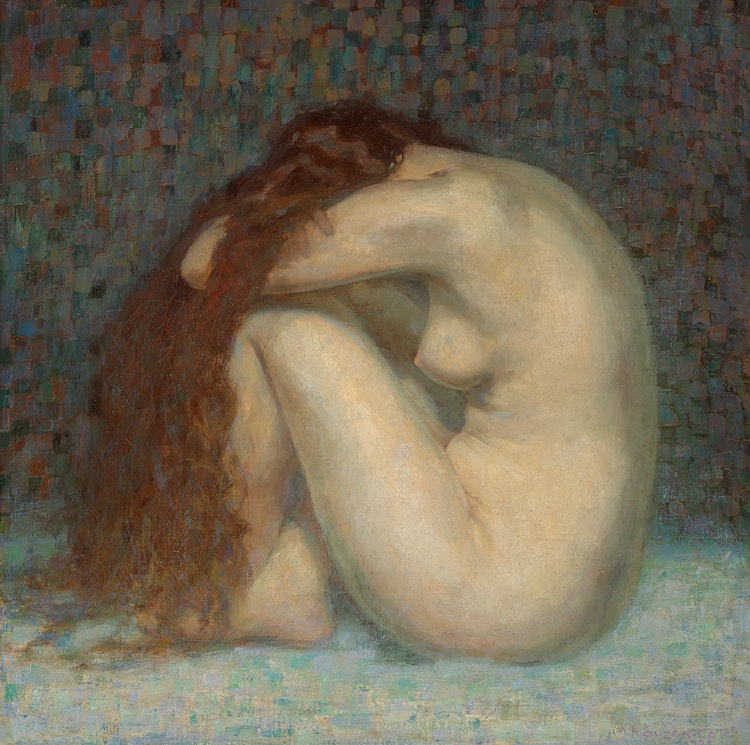
Fernando Botero is a celebrated Colombian artist renowned for his paintings and sculptures that explore and experiment with the proportion and size of humans and animals. The artist’s tactile and sensual approach to the representation of rotund, whimsical figures in his paintings is a hallmark of his singular style. Consistently manipulating space and perspective, Botero is influenced by his studies of the Italian Old Masters and discovery of modern artistic movements, such as Abstract Expressionism. Botero remains connected to the artistic culture of Latin America in his oeuvre, inspired by Spanish master painters and Mexican muralists, while exposure to modernist influences have expanded his painterly practice.
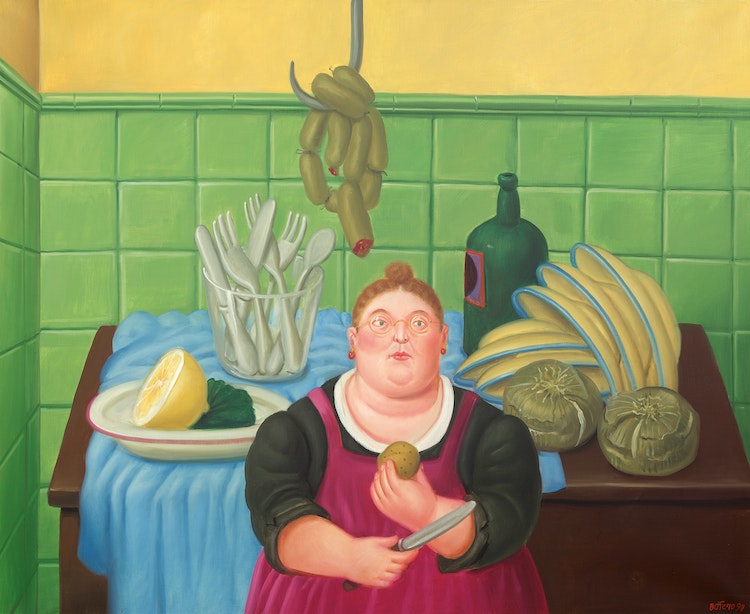
In “The Kitchen”, Fernando Botero has created a sense of unease with his placement of a lone female figure directly in the center of the composition. The expression on the figure’s face is unreadable. Botero has captured the figure in the middle of the simple culinary act of peeling a potato with knife in hand, frozen by the intrusion of the viewer’s gaze. She is one of the artist’s characteristic voluminous matronly figures and is depicted in one of the most important locations in a home, the kitchen.
The table behind the female figure presents an abundant still life, set against vibrant green tiles. Fresh sausages hang on a meat hook to dry just above a glass vase filled with knives, forks and a single spoon. A large bottle of wine and a collection of yellow dishes are stacked, ready to be used for serving. Two large, juicy onions and a perfectly ripe lemon that has been sliced in half complete the still life arrangement, all presented on top of a gathered blue tablecloth.
John Sillevis writes: “There is certainly a reference to the masterpieces of Dutch seventeenth-century still life in Botero’s predilection for ‘la nature morte’. Botero is able to create the most extraordinary effects in his still lifes. He inserts a sense of menace or uneasiness into an arrangement of fruits and flowers. In Dutch art of the Golden Age, still life painting also had different layers of meaning.” Dutch genre painting was not simply a depiction of ‘everyday life’, but incorporated elements to convey moral overtones, remarking upon the vanities of worldly pleasures and the dangers of vice.
Botero’s paintings of the 1990s were often explorations of the still life in various forms, employing painterly devices and drawing upon the thread of Dutch genre painting. The overt symbolism of “The Kitchen” is revealed through the various objects Botero has chosen to include. The sliced lemon can be read as sourness or bitterness, but it can also serve as a symbol of ephemerality or the passage of time. The word for onion comes from the Latin uniothat, meaning oneness or unity, and the bottle of wine, which is always associated with the divine, may also symbolize prestige, uniqueness, wealth, and integrity.
Botero’s quintessential use of flat, bright colours and boldly outlined forms in this painting are characteristic of his signature style, while the inclusion of foods found in a traditional Colombian kitchen add a layer of nostalgia to this monumental painting. “The Kitchen” captures Botero’s enduring fascination with the tradition of still life painting, presenting the art form as current and contemporary.
During the 1912 Northern British Columbia travels which would result in Emily Carr’s early paintings of Indigenous subjects, the artist was unable to visit the village of Kitwancool because the Gitsxan people had little time for outsiders in their community. However, in 1928, Carr was able to visit Kitwancool. Discussing her visit to the village, Carr said: “The thought of those old Kitwancool poles pulled at me.” Carr would work for six days in the community, telling locals “I want to make some pictures of the totem poles…because they are beautiful.”
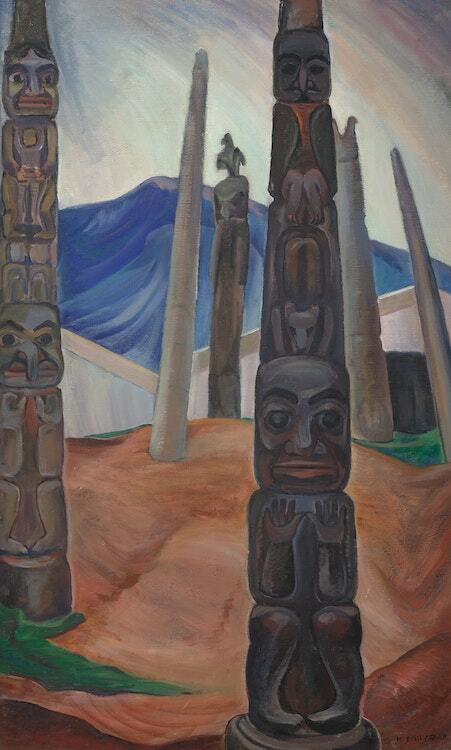
Emily Carr “Kitwancool” circa 1928, oil on canvas, 44 x 26.75 ins, Estimated: $1,00,000-1,500,000
When Carr returned to her Victoria studios, she created several canvases from her sketches. A related canvas, Corner of Kitwancool Village, now part of the McMichael Canadian Art Collection, shares compositional elements with this painting, depicting two poles in the village in some detail and shows several other poles and longhouses in the background and a distant mountain.
This painting was first shown at Montreal’s Dominion Gallery in 1944, along with the McMichael canvas. Emily Carr historian, Ian Thom, believes that this canvas is the later of the two artworks and the more dynamic of the pair of paintings. Thom sees this painting as more challenging compositionally, with a vigorously delineated fore and middle ground, and Carr has made the sky in Kitwancool more active than in the earlier canvas.
Carr spoke further of her time in Kitwancool, saying “The sun enriched the old poles grandly. They were carved elaborately and with great sincerity. Several times the figure of a woman that held a child was represented.” This mother figure appears, in the pole of Weer-hae, on the left of the composition.
Ian Thom notes that what is most striking about Kitwancool is how vividly Carr has captured the beauty of these majestic totem poles, proud sentinels of the Gitxsan nation. The poles are indeed “enriched” by the sunlight which streams in from the left and Carr has conveyed their sincerity and power. Kitwancool makes its auction debut with Cowley Abbott as part of the Spring Live Auction of Artwork from an Important Private Collection on June 8th.
View the complete catalogue listing for this Emily Carr work on our website, with further exhibition and provenance information. https://cowleyabbott.ca/artwork/AW42517
Vente en direct du printemps: une importante collection d’art privée
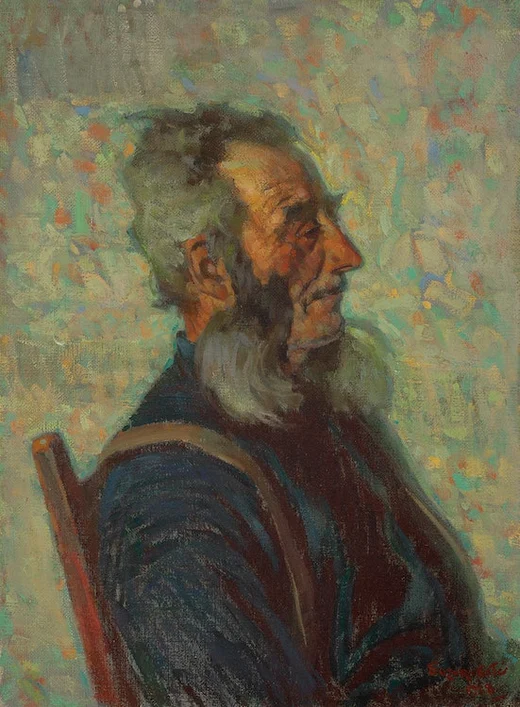
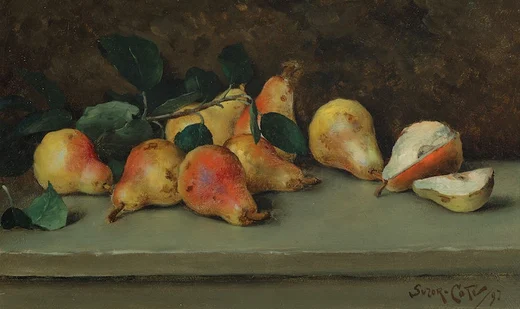
La vente aux enchères printanière comprend une sélection fantastique d’œuvres d’art par des artistes québécois de sujets québécois. L’un des lots phares est un portrait d’un colon d’Athabaska par Marc-Aurèle de Foy Suzor-Coté. Tel que décrit par Laurier Lacroix : “La sobriété du traitement de la chemise bleu foncé contraste avec le traitement du fond où se côtoient des taches brunes, vertes et jaunes pales.”
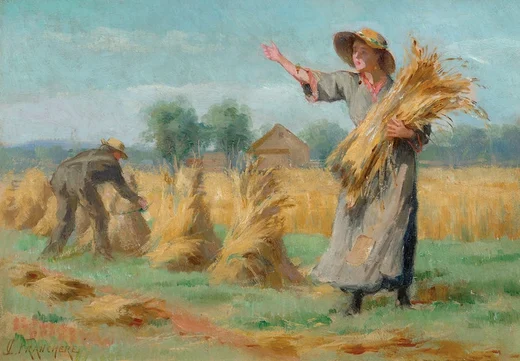

Les toiles d’artistes québécois par excellence, tels que Joseph-Charles Franchère et Charles Huot, célèbrent la vie rurale canadienne. La moisson attire notre attention sur la récolte, tandis que Interior with Seated Figures dépeint “le père et la mère Godbout d’Île d’Orléans” dans un environnement typiquement canadien-français.


Deux portraits par Théophile Hamel nous ont également été confiés. Hamel a commencé sa carrière à l’âge de seize ans, lorsqu’il a accepté un apprentissage auprès d’Antoine Plamondon, l’artiste québécois le plus en vue à l’époque.

Nous avons le privilège de présenter l’exquis tableau À Venise de James Wilson Morrice qui sert d’étude pour la toile Red Houses, Venice, faisant partie de la collection du Musée des beaux-arts de Montréal.
Cette vente est une occasion rare d’acquérir une importante œuvre d’art canadien historique de ces artistes de renom. Nous avons l’honneur de continuer à présenter ces œuvres d’art sur le marché en prévision de notre vente aux enchères du 8 juin.
We are pleased to share Cowley Abbott’s Spring Live Auction catalogues, featuring Important Canadian & International Artwork (Session 1) and An Important Private Collection of Canadian Art (Session 2).
It is our privilege to continue to introduce Canadian artwork from the Important Private Collection to the auction market. Following the record-breaking success of the December 2022 first session from the collection, this next offering is another landmark sale which includes a selection of rare and remarkable historical artwork, most of which will be making its auction debut with Cowley Abbott this spring.
The first session features rare and important artwork from Canadian and international artists with masterpieces debuting at auction from cherished private, public and corporate collections.
Please join us in Toronto beginning May 8th to view these important artworks and gain insight on these masterworks ahead of the June 8th live auction at Toronto’s Globe & Mail Centre.

